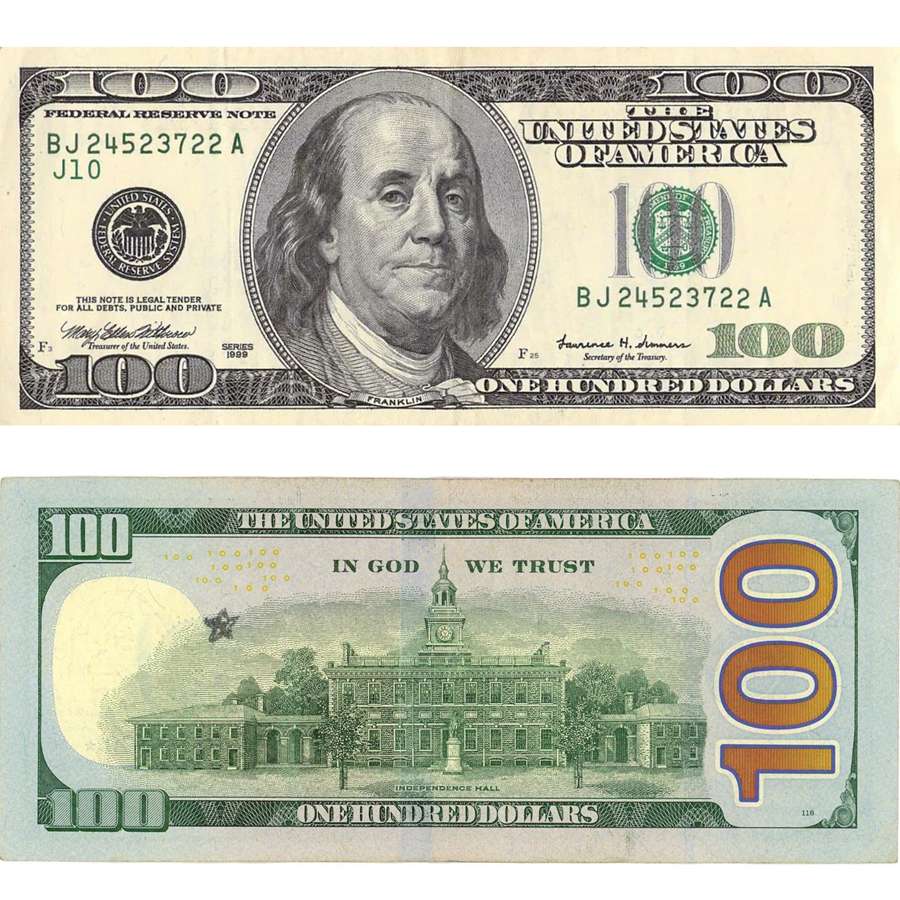Welcome to DollarToNaira (https://www.dollartonaira.today), your trusted source for the latest exchange rates between the US Dollar (USD) and the Nigerian Naira (NGN). We are dedicated to providing accurate, up-to-date information and tools to help you navigate the complexities of Nigerian currency exchange.
US Dollar To Nigerian Naira Exchange Rate
$USD 🇺🇸 → ₦NGN 🇳🇬
Black Market (Aboki) Rate

Buy Rate: ₦ 1,596.00 Naira
Sell Rate: ₦ 1,610.00 Naira
The Black Market (Aboki) exchange rate today is ₦ 1,596.00 if you want to change your Dollar to Naira (you get ₦ 1,596.00 for every dollar you sell), and ₦ 1,610.00 if you want to change your Naira to Dollar (you pay ₦ 1,610.00 for every dollar you buy).
Central Bank (CBN) Official Rate

Buy Rate: ₦ 1,662.90 Naira
Sell Rate: ₦ 1,663.90 Naira
The Central Bank (CBN) Official exchange rate today is ₦ 1,662.90 if you want to change your Dollar to Naira (you get ₦ 1,662.90 for every dollar you sell), and ₦ 1,663.90 if you want to change your Naira to Dollar (you pay ₦ 1,663.90 for every dollar you buy).
International Foreign Exchange (Forex) Rate

Buy Rate: ₦ 1,606.56 Naira
The International Foreign Exchange (Forex) exchange rate today is ₦ 1,606.56 if you want to change your Dollar to Naira (you get ₦ 1,606.56 for every dollar you sell).
Nigerian Naira to US Dollar
₦NGN🇳🇬→ $USD🇺🇸
🇺🇸USD What is Buy Rate?
The buy rate is the exchange rate you receive when you sell your dollar. Although dollars may be scarce, buyers typically purchase dollars at a lower rate than they sell them. This allows buyers to make a profit when they resell the dollars at a higher rate.
What is Sell Rate?
The sell rate is the exchange rate you get when you buy a dollar or exchange your Naira for dollars. This rate is usually not favorable to the buyer of dollars due to the abundance of Naira and the scarcity of dollars.
What Is Central Bank (CBN) Exchange Rate?
The official exchange rate set by the Central Bank of Nigeria (CBN) represents the value at which the central bank will buy and sell the Nigerian naira for foreign currencies, primarily the US dollar. This rate is crucial for various economic activities, including international trade, foreign investment, and government financial operations. The official exchange rate is typically determined by the CBN through its monetary policies and foreign exchange management strategies to maintain economic stability and control inflation.
- Purpose: The official rate is used to stabilize the currency, control inflation, and manage the country’s foreign exchange reserves. It is also used for governmental transactions and for determining the economic policies of the country.
- Determination: It is influenced by the CBN’s monetary policy, international economic conditions, and the supply and demand for foreign currencies within the regulated market.
What Is Foreign Exchange (Forex) Rate?
The foreign exchange rate at which banks trade currencies among themselves and with large corporations, often referred to as the interbank exchange rate, is an important mechanism in the global financial system. This rate is typically very close to the official exchange rate set by a country’s central bank, but it can fluctuate more frequently based on immediate market conditions.
- Purpose: Used for large-scale financial transactions, international trade, currency trades and by businesses for importing goods and services.
- Determination: Determined by the interbank market based on real-time supply and demand, but influenced by the CBN’s interventions and policies.
What Is Black Market (Aboki) Exchange Rate?
The parallel market rate, also known as the black market rate, is the exchange rate at which currencies are traded outside of officially regulated financial institutions. This market operates unofficially and often has significant discrepancies compared to the official exchange rates set by central banks.
- Purpose: Individuals and businesses often use the black market rate when they cannot access foreign currency through official channels due to restrictions, shortages, or regulations imposed by the CBN.
- Determination: Driven purely by market forces of supply and demand, often reflecting a higher exchange rate due to scarcity of foreign currency in the official market. The black market rate can be more volatile and is influenced by economic instability, speculation, and regulatory limitations.
What Is the Nigerian Naira Symbol?
The symbol for the Nigerian Naira is “₦”. This symbol represents the currency of Nigeria, the Naira, abbreviated as NGN. The Naira symbol “₦” is characterized by a capital ‘N’ with two horizontal lines running through it. These lines are similar to those found in the dollar sign “$” or the euro sign “€”, signifying it as a currency symbol.
Nigerian Naira In Nigerian Languages
Yoruba: náírà Hausa: نَيْرَ Romanized: naira Igbo: naịra Tyap: nera
On digital platforms and in typesetting, the Naira symbol can be created using Unicode U+20A6. In HTML, it can be represented by ₦ or &8358;.
The Naira is the official currency of Nigeria, introduced in 1973 to replace the Nigerian Pound. It is subdivided into 100 Kobo. The symbol “₦” is widely recognized within Nigeria and among global financial markets dealing with Nigerian currency.
Example of Usage:
- In a Nigerian market, you might see prices listed as:
- Bread: ₦500
- Rice (per kg): ₦300
- Transportation fare: ₦100
Like other currency symbols, the Naira symbol helps to quickly identify the monetary unit in question. For instance:
-
-
- Dollar (USD): $
- Euro (EUR): €
- Pound Sterling (GBP): £
-
The Naira symbol is included in most modern fonts and is easily accessible on digital devices. On a Windows computer, it can be typed by holding down the Alt key and typing 8358 on the numeric keypad.
What Is the US Dollar Symbol?
The symbol for the US Dollar is “$”. This symbol is widely recognized and used globally to represent the currency of the United States, which is abbreviated as USD. The dollar symbol “$” is characterized by an ‘S’ with one or two vertical lines through it.
The version with one line is more common. The exact origin of the symbol is debated, but it is believed to have evolved from the Spanish peso, which was marked as “PS” and gradually simplified into “$”.
On digital platforms and in typesetting, the dollar symbol is universally included in most fonts and keyboard layouts. In HTML, it can be represented by $.
Example of Usage:
- In a US market, you might see prices listed as:
- Bread: $2.50
- Rice (per lb): $1.20
- Transportation fare: $3.00
- Like other currency symbols, the dollar symbol helps to quickly identify the monetary unit in question. For instance:
- Euro (EUR): €
- Pound Sterling (GBP): £
- Japanese Yen (JPY): ¥
- The dollar symbol is included in all modern fonts and is easily accessible on digital devices. On a standard keyboard, it can be typed by pressing the
Shiftkey and the number4key.
Nigerian Naira Banknotes & Coins
Coins
K50 kobo Coin
The 50 kobo coin, the smallest denomination, stands out with its 24.5 mm diameter and distinctive 12-sided polygonal design. Made from nickel, one face proudly showcases the Nigerian Coat of Arms, the inscription ‘Federal Republic of Nigeria,’ and the year it was minted. The opposite side features an intricate depiction of maize cobs and the coin’s denomination, ’50 kobo’.
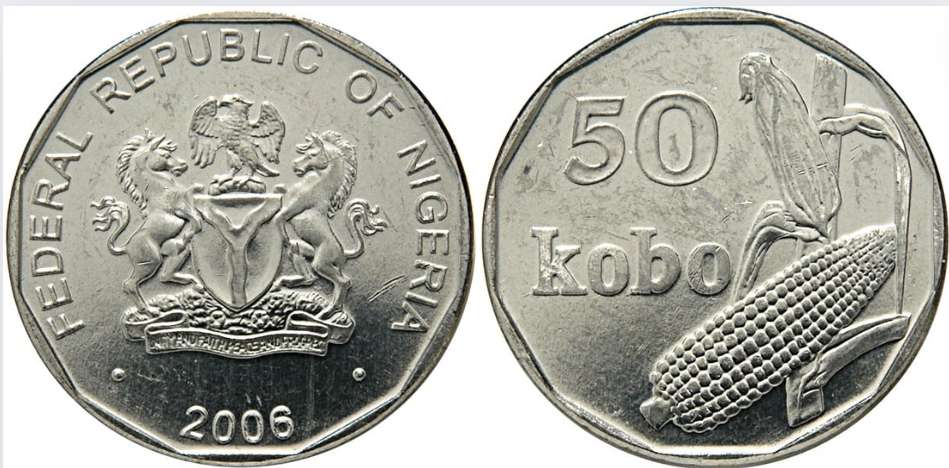
₦1 Naira Coin
The One Naira coin, with a diameter of 27.5 mm, boasts a round shape and is crafted from steel coated in a brass finish. The front side (obverse) showcases the Nigerian Coat of Arms and the year of minting set within an inner circle adorned in brass. Encircling this, the outer ring, which retains the steel hue, is inscribed with ‘Federal Republic of Nigeria’ and ‘CBN’. On the flip side (reverse), a portrait of the esteemed Nigerian statesman, Herbert Macaulay, along with his lifespan (1864-1946), is prominently featured, complemented by the denomination written in words.
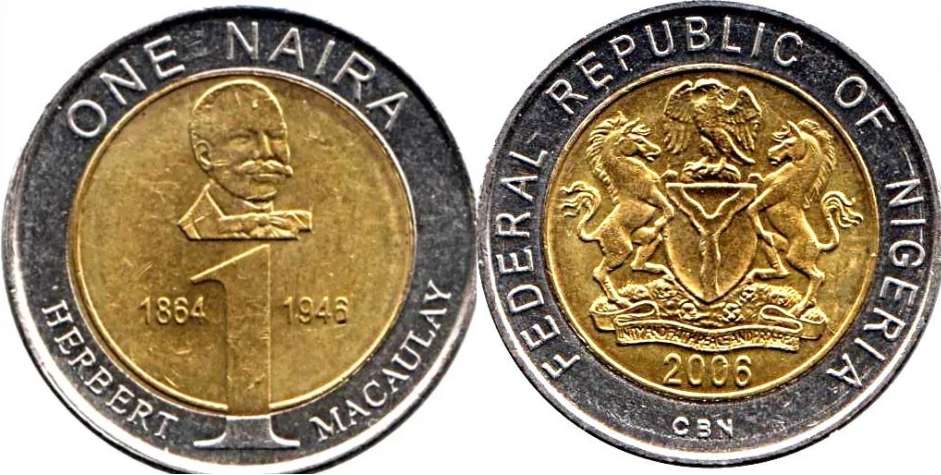
₦2 Naira Coin
The Two Naira coin, first minted in 2007, boasts a 24.5 mm diameter and is circular in form, crafted from steel with a copper overlay. On its obverse, the Nigerian Coat of Arms takes center stage within a brass-toned inner circle, flanked by the minting year. Encircling this is the outer ring, featuring the inscriptions ‘Federal Republic of Nigeria’ and ‘CBN’ in a contrasting steel shade. The reverse side showcases an illustration of the National Assembly Building in Abuja, crowned by a prominent number “2,” and encircled by the words ‘two naira’.
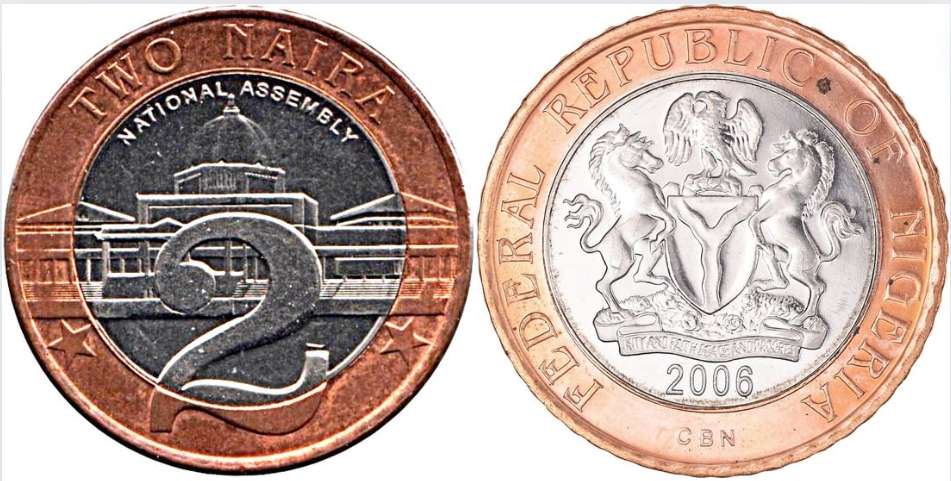
Banknotes
₦5 Naira Note
The 5 Naira banknote, issued by the Central Bank of Nigeria, features Alhaji Sir Abubakar Tafawa Balewa on the front, alongside tactile marks for the visually impaired, a transparent window for security, and a unique serial number. The back showcases a see-through image, a G-Switch for anti-counterfeiting, and cultural imagery. The note is designed with vibrant colors and inscriptions in multiple Nigerian languages, reflecting Nigeria’s rich heritage. These advanced security features ensure the note’s durability and authenticity, making it a reliable piece of currency in Nigeria’s financial system.
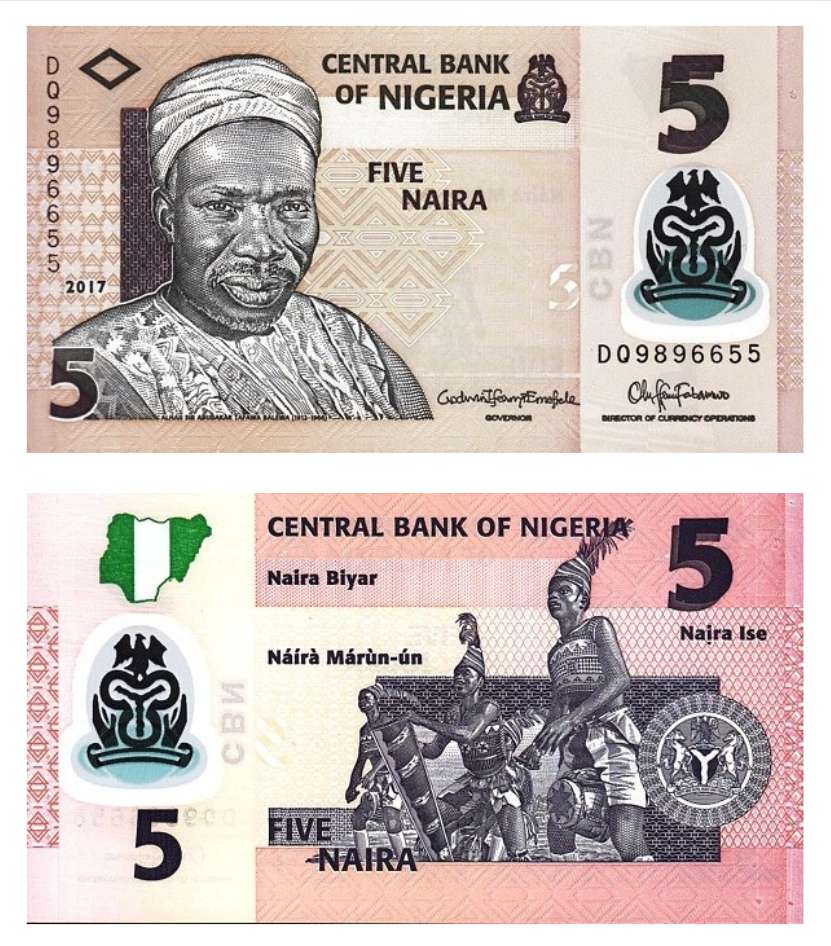 ₦10 Naira Note
₦10 Naira Note
The 10 Naira banknote, issued by the Central Bank of Nigeria, features Dr. Alvan Ikoku on the front, along with tactile marks for the visually impaired, a transparent window for added security, and a unique serial number. The back of the note displays a see-through image and a G-Switch for anti-counterfeiting, complemented by cultural imagery. The note is adorned with vibrant colors and inscriptions in multiple Nigerian languages, highlighting Nigeria’s cultural diversity. These advanced security features ensure the note’s durability and authenticity, making it a reliable and secure element of Nigeria’s financial system.
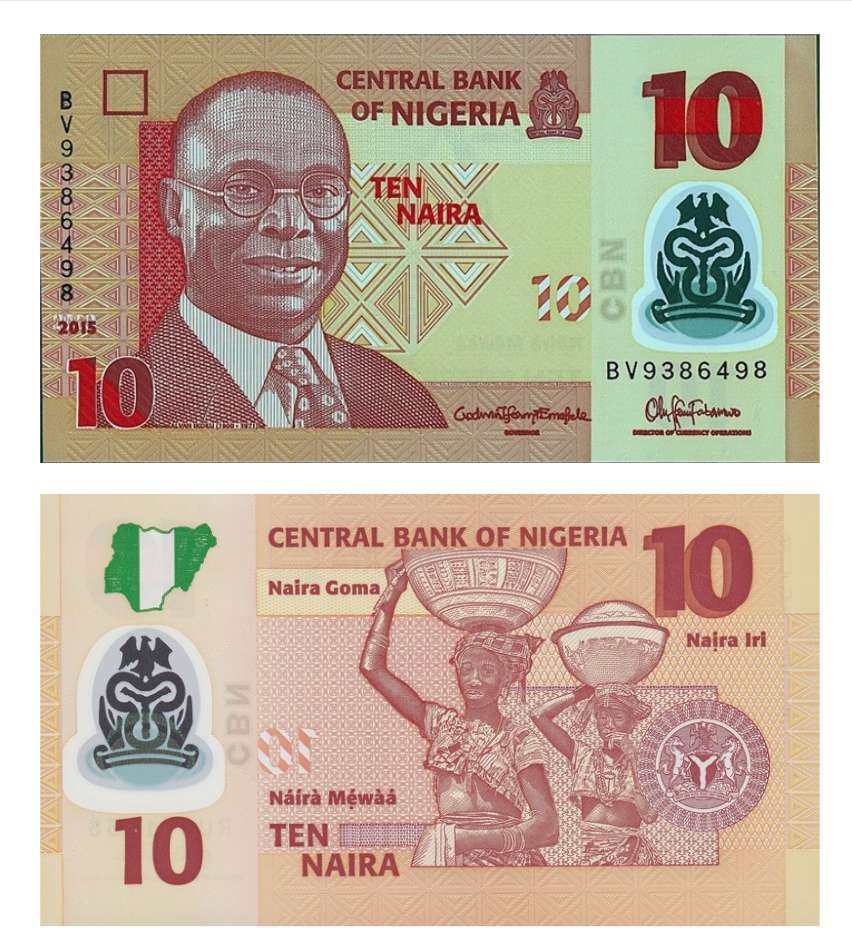
₦20 Naira Note
The 20 Naira banknote, issued by the Central Bank of Nigeria, features General Murtala Mohammed on the front, along with tactile marks for the visually impaired, a transparent window for security, and a unique serial number. The back of the note displays a see-through image and a G-Switch for anti-counterfeiting, complemented by an illustration of a traditional Nigerian woman. Adorned with vibrant green colors and inscriptions in multiple Nigerian languages, the note highlights Nigeria’s cultural diversity. These advanced security features ensure the note’s durability and authenticity, making it a reliable and secure element of Nigeria’s financial system.
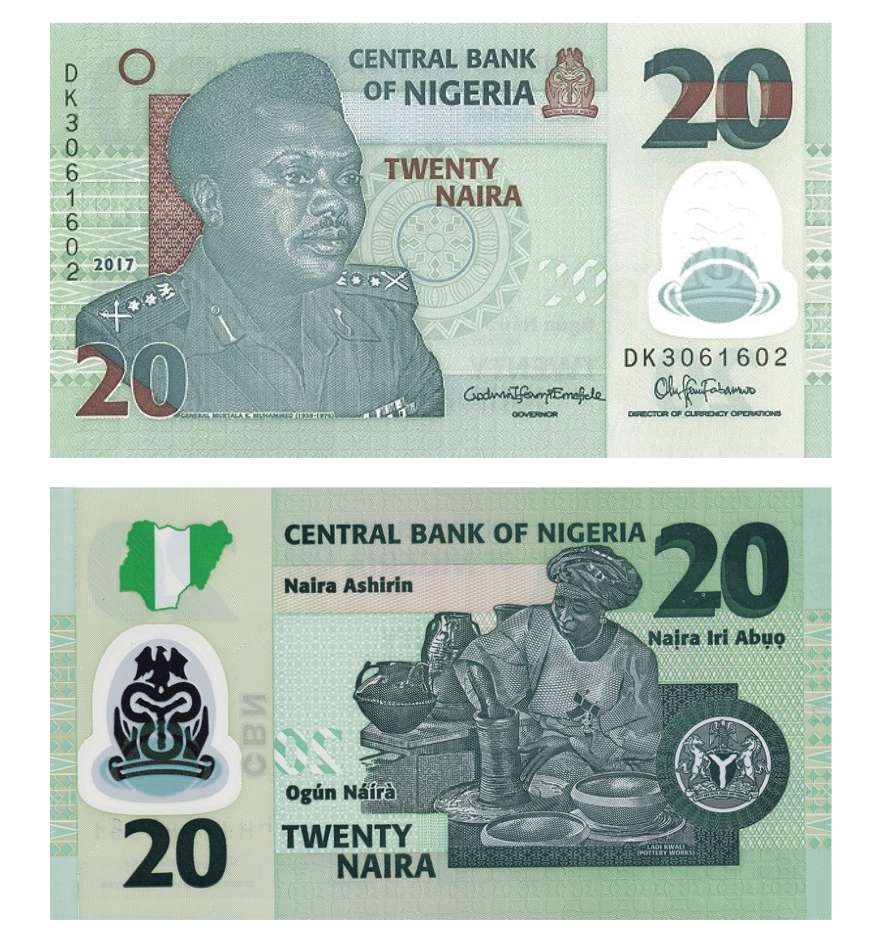 ₦50 Naira Note
₦50 Naira Note
The 50 Naira banknote, issued by the Central Bank of Nigeria, features three prominent Nigerian citizens on the front, along with tactile marks, a transparent window, and a unique serial number. The back depicts a group of fishermen, complemented by a see-through image and a G-Switch for anti-counterfeiting. The note is adorned with blue colors and inscriptions in multiple Nigerian languages, reflecting Nigeria’s cultural heritage and security measures to ensure authenticity and durability.
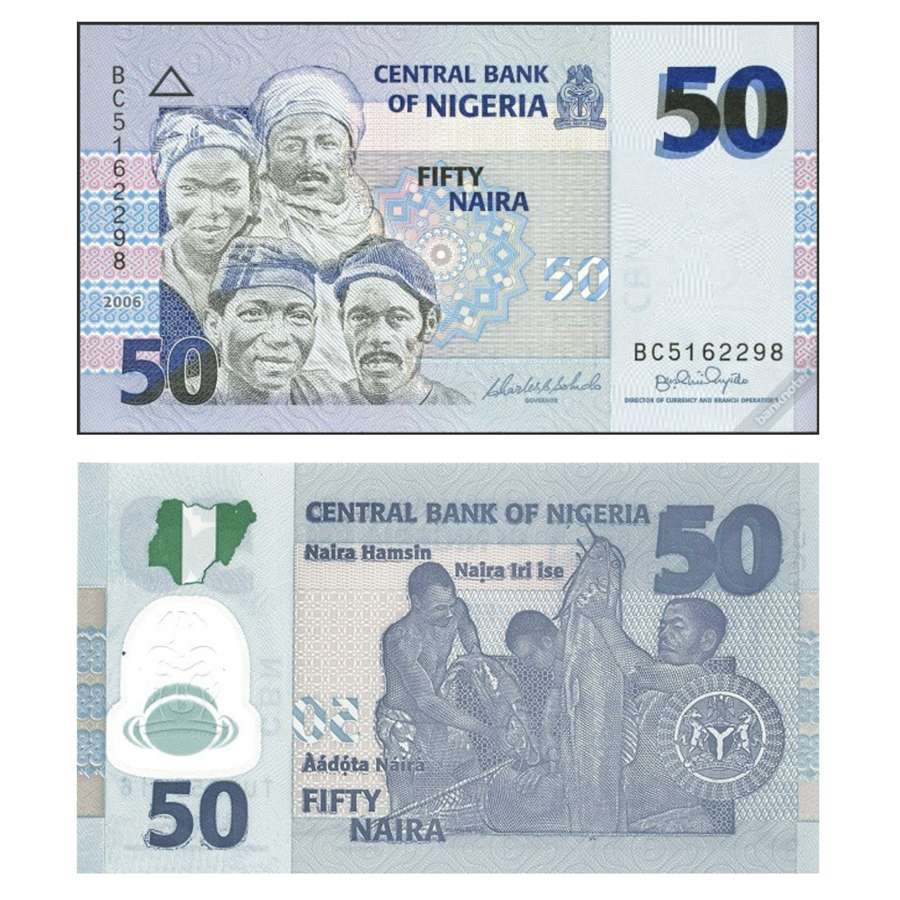 ₦100 Naira Note
₦100 Naira Note
The 100 Naira commemorative banknote, issued by the Central Bank of Nigeria, features Chief Obafemi Awolowo on the front, along with intaglio raised print, tactile marks, a transparent window, and a unique serial number. The back showcases cultural images and a QR code, complemented by a see-through image. The note also includes advanced features like an electrotype watermark and OVMI ink, enhancing security and authenticity with vibrant design elements.
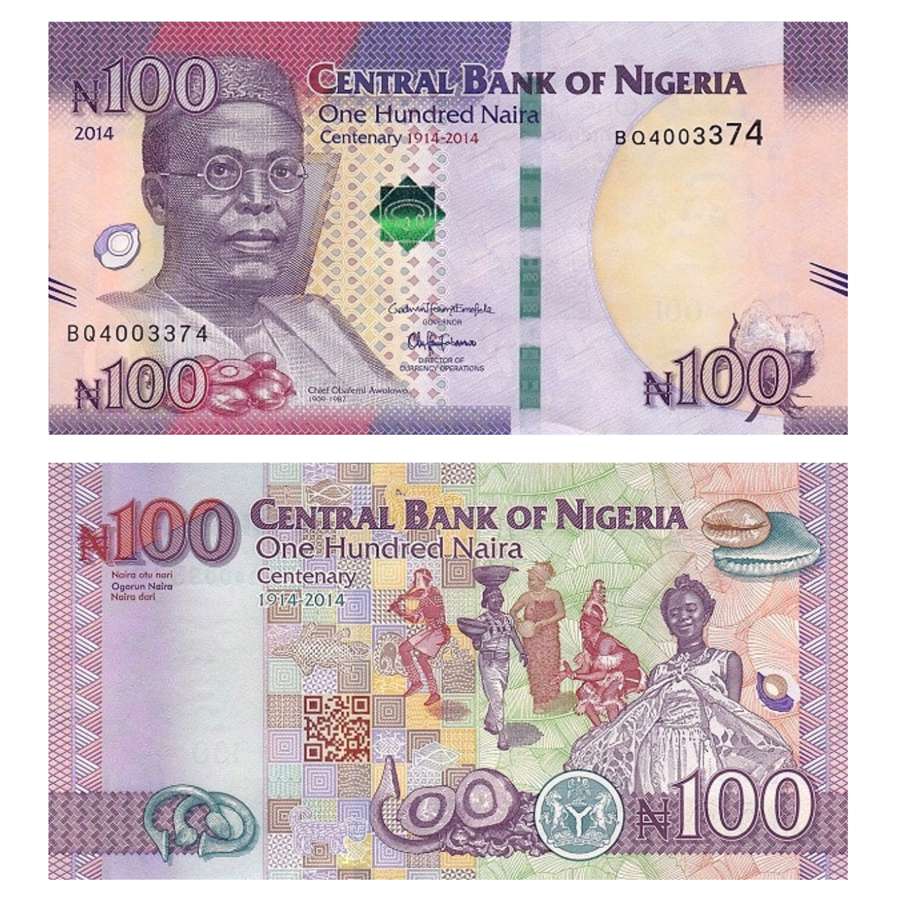 ₦200 Naira Note
₦200 Naira Note
The 200 Naira banknote, issued by the Central Bank of Nigeria, features Alhaji Sir Ahmadu Bello on the front, with a gold patch, tactile marks, a transparent window, and a unique serial number. The back shows agricultural motifs, complemented by a see-through image and cultural illustrations. The note’s design incorporates multiple languages and advanced security features such as a windowed metallic thread and optically variable ink to ensure authenticity and security.
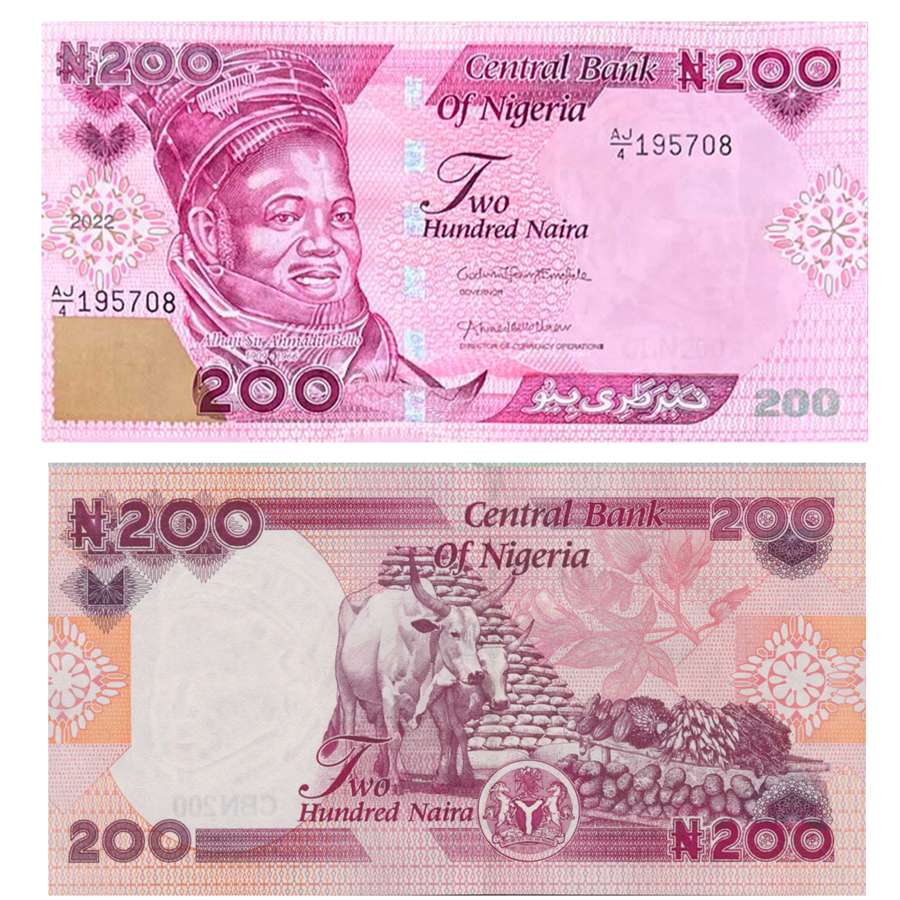 ₦500 Naira Note
₦500 Naira Note
The 500 Naira banknote, issued by the Central Bank of Nigeria, features Dr. Nnamdi Azikiwe on the front, with a silver patch, tactile marks, a transparent window, and a unique serial number. The back depicts cultural scenes, complemented by a see-through image and advanced security features like a windowed metallic thread and optically variable ink. The note’s green hues and intricate designs highlight Nigeria’s rich heritage and ensure its authenticity and security.
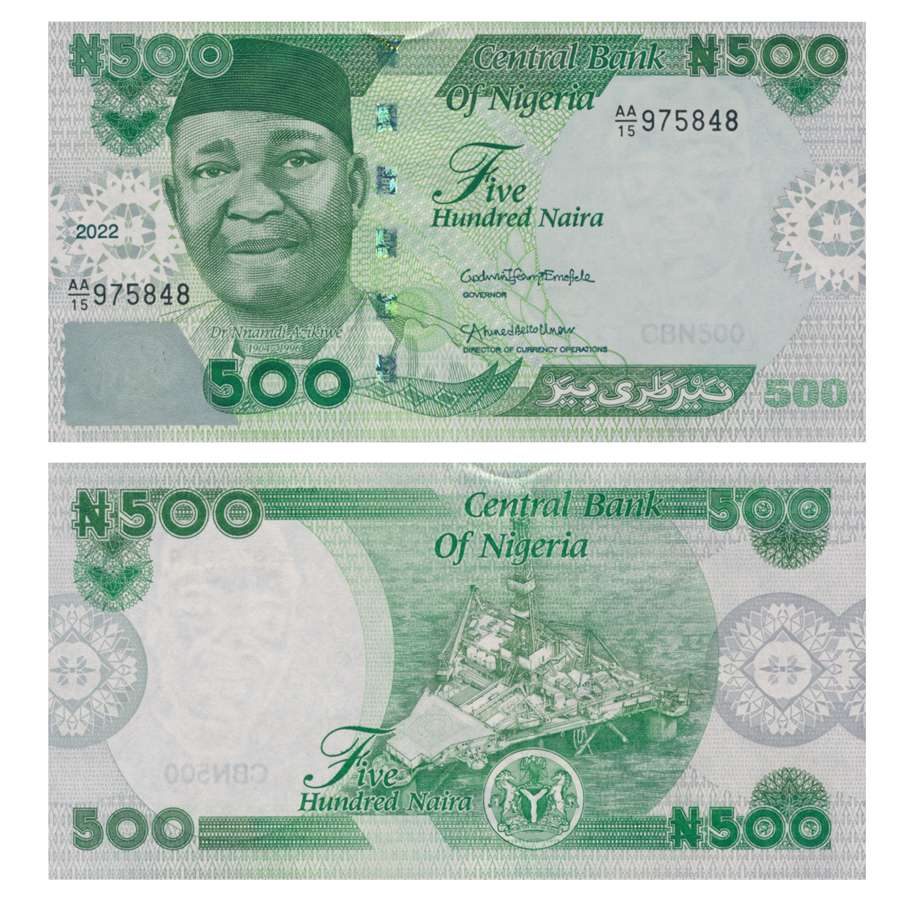 ₦1000 Naira Note
₦1000 Naira Note
The 1000 Naira banknote, issued by the Central Bank of Nigeria, features portraits of Alhaji Aliyu Mai-Bornu and Dr. Clement Isong on the front, with a kinegram, tactile marks, a transparent window, and a unique serial number. The back showcases the CBN head office, complemented by a see-through image and advanced security features like an iridescent band and optically variable ink. The note’s blue tones and sophisticated design elements reflect Nigeria’s commitment to secure and durable currency.
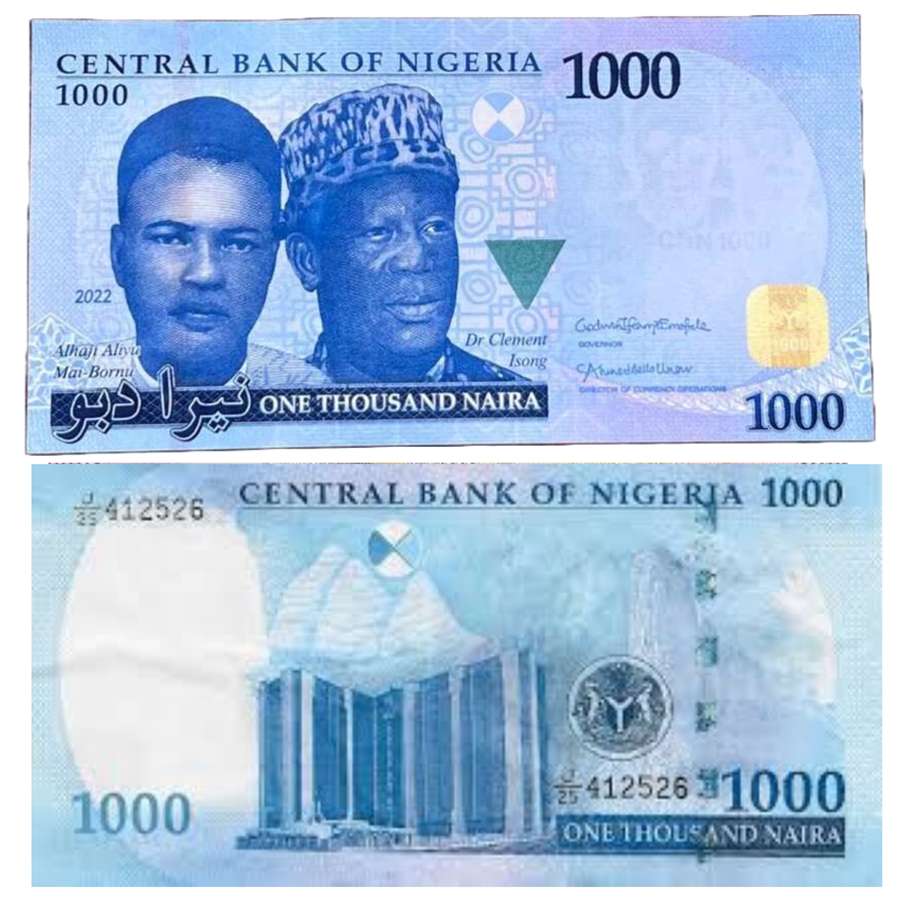
US Dollar Banknotes & Coins
Coins
US Penny
The Penny, a one-cent coin, is crafted from copper-plated zinc and features the image of Abraham Lincoln on its obverse side. The reverse side commonly displays the Lincoln Memorial or the Union Shield. This coin, although of the smallest denomination, holds significant historical value and is widely used in everyday transactions.
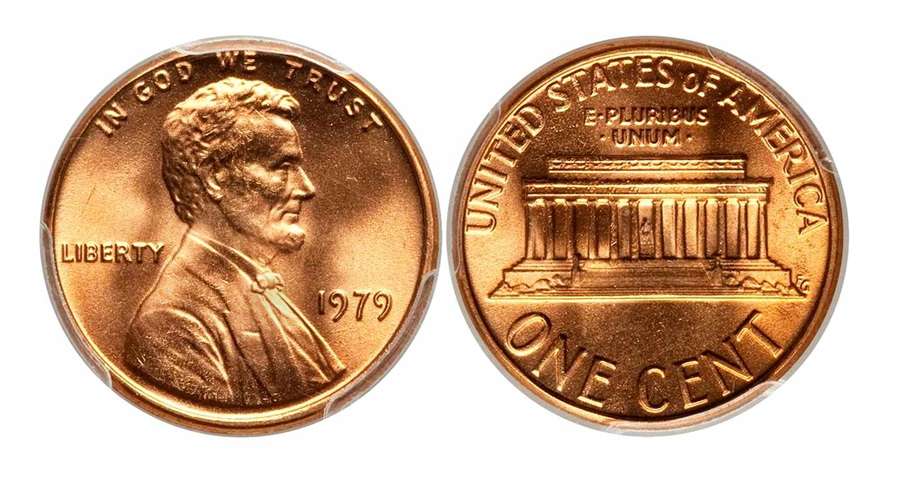
US Nickel
The Nickel, valued at five cents, is made from a blend of copper and nickel. The obverse side features Thomas Jefferson, while the reverse showcases his estate, Monticello. This coin is known for its durability and distinct design, making it a staple in U.S. currency.
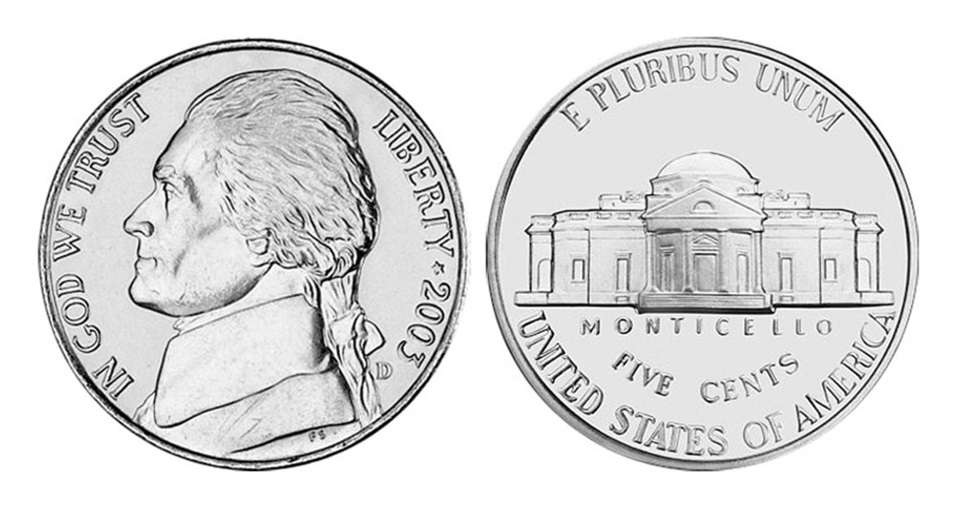
US Dime
The Dime, a ten-cent coin, is also made from a copper-nickel blend. It bears the portrait of Franklin D. Roosevelt on the obverse, with the reverse displaying a torch flanked by an olive branch and an oak branch. The Dime is the smallest in diameter but holds significant purchasing power relative to its size.
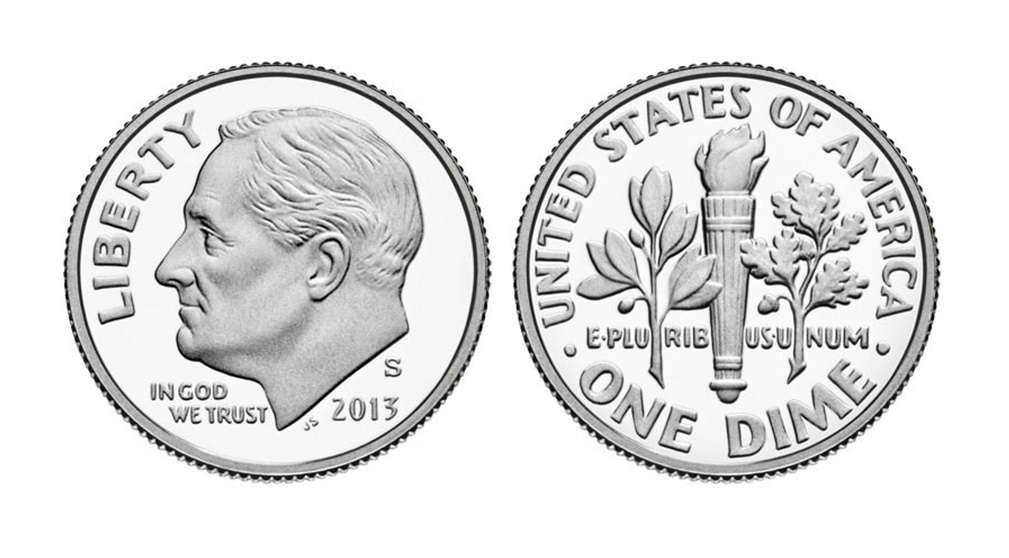
US Quarter
The Quarter, worth twenty-five cents, is made of a copper-nickel blend and features George Washington on the obverse. The reverse varies, often depicting state-specific designs or national parks. This coin is widely used and appreciated for its versatile design and commemorative editions.
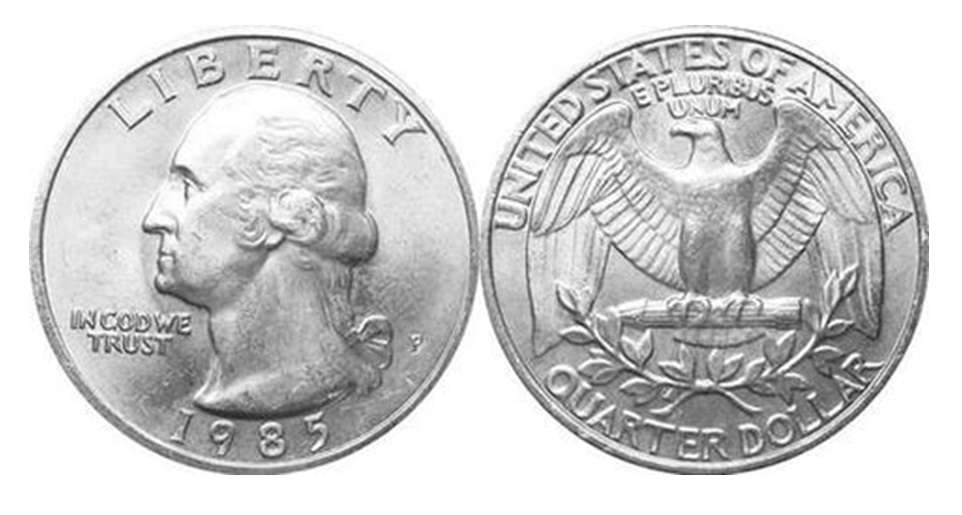
Banknotes / Bills
$1 Dollar Bill
The US$1 banknote features George Washington on the front and the Great Seal of the United States on the back. This note is the most commonly circulated and recognized, playing a crucial role in everyday transactions and symbolizing American currency.
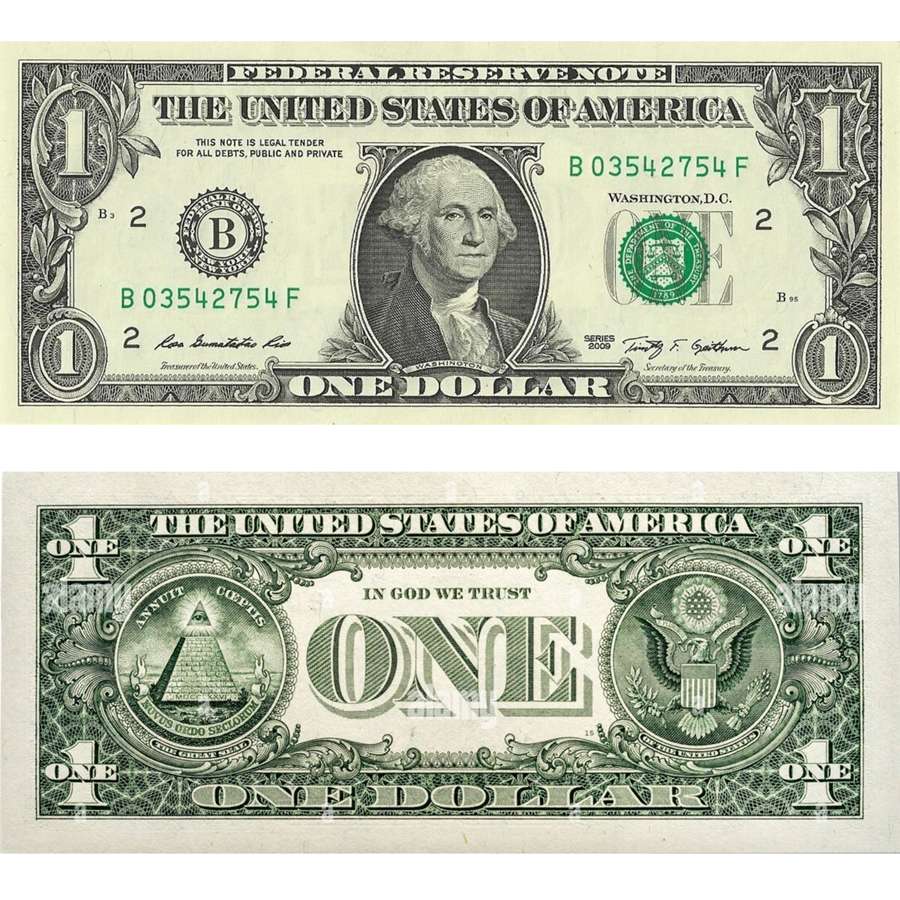
$5 Dollar Bill
The US$5 banknote depicts Abraham Lincoln on the front, with the Lincoln Memorial on the back. This note is essential in daily commerce and reflects the historical significance of Lincoln’s contributions to the United States.
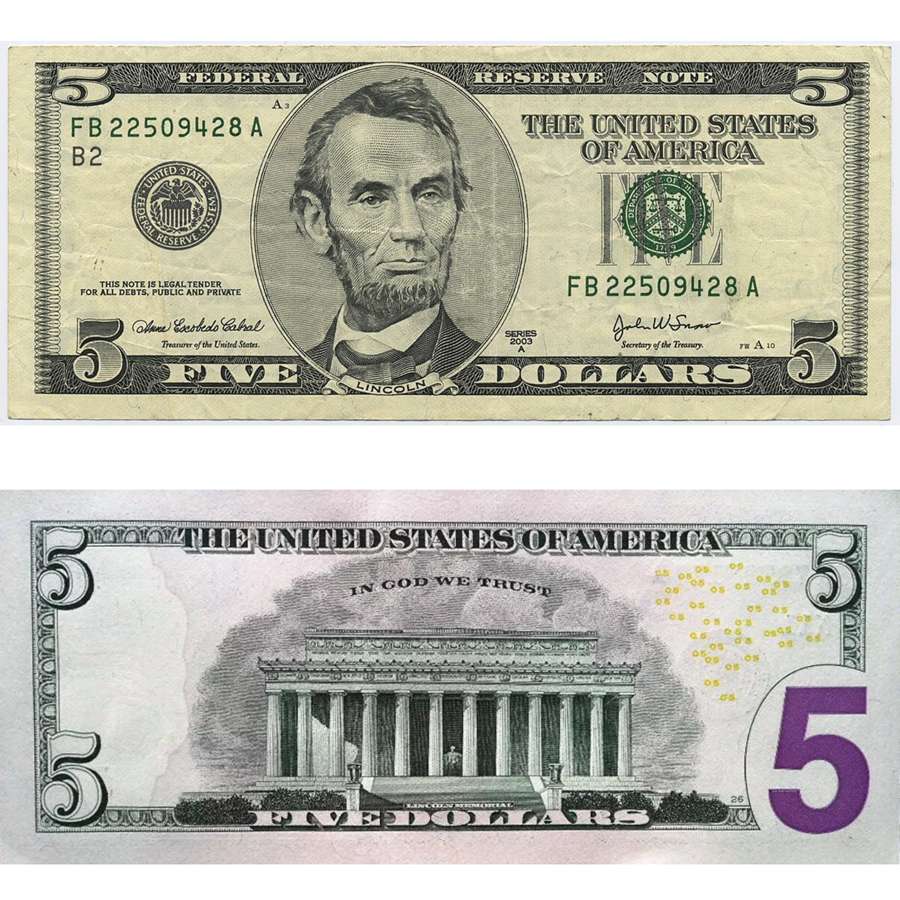
$10 Dollar Bill
The US$10 banknote shows Alexander Hamilton on the front and the U.S. Treasury building on the back. Hamilton, a founding father and the first Secretary of the Treasury, is honored on this note, which is widely used in transactions.
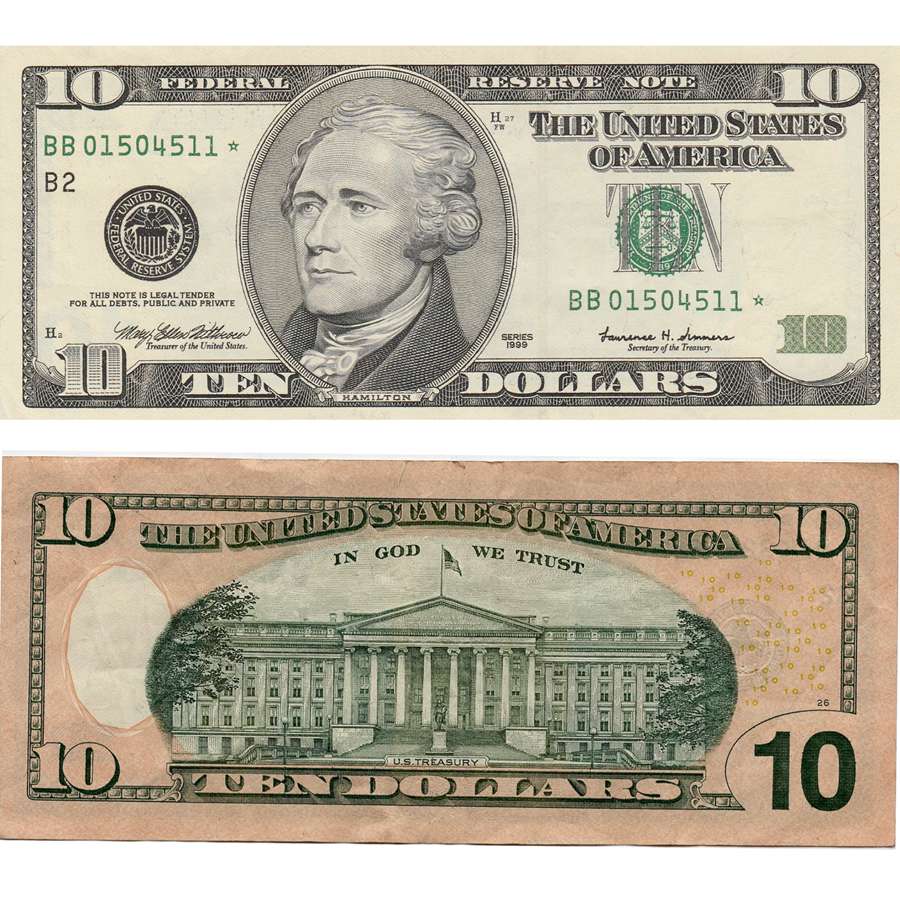
$20 Dollar Bill
The US$20 banknote features Andrew Jackson on the front and the White House on the back. This denomination is frequently used for larger transactions and is easily recognizable with its distinct design.
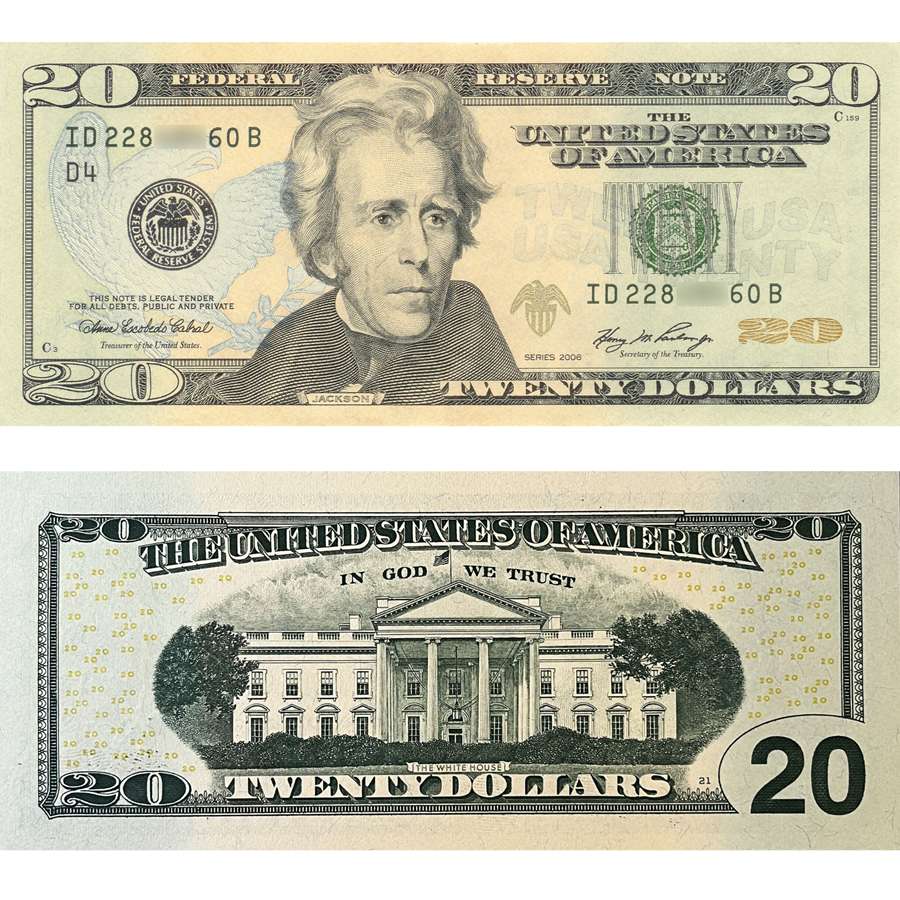
$50 Dollar Bill
The US$50 banknote displays Ulysses S. Grant on the front and the U.S. Capitol on the back. Grant, a Civil War general and U.S. President, is commemorated on this note, which is used for significant transactions and often stored as reserves.
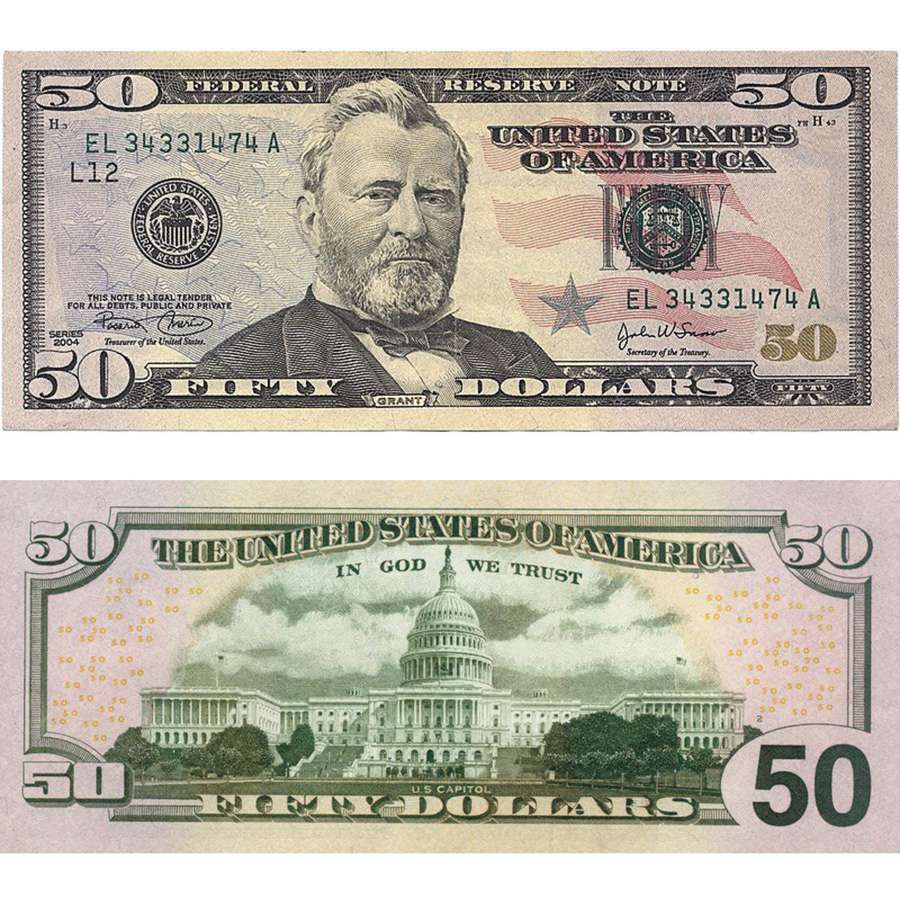
$100 Dollar Bill
The US$100 banknote depicts Benjamin Franklin on the front and Independence Hall on the back. Known as the highest denomination commonly circulated, this note is used for substantial transactions and savings, reflecting Franklin’s legacy in American history.
